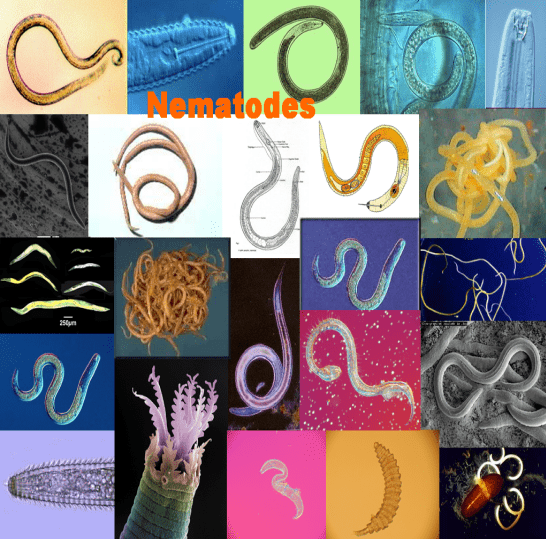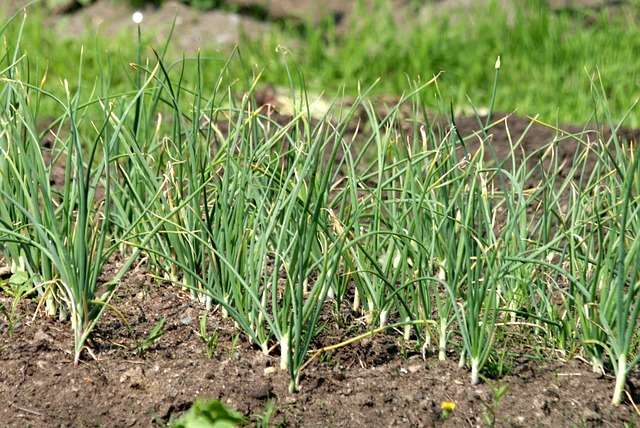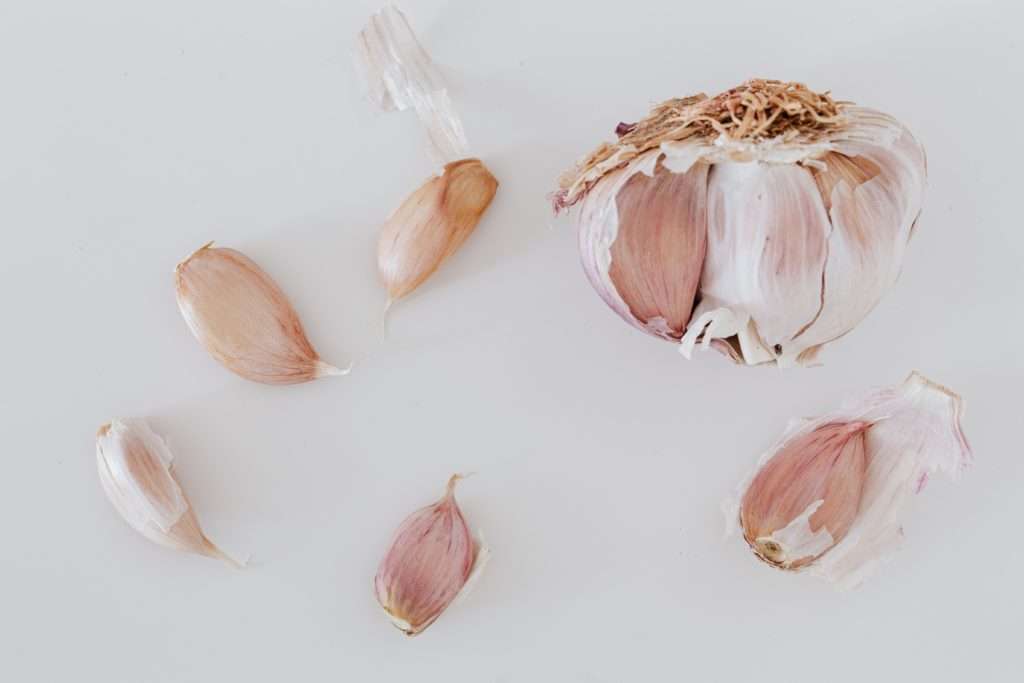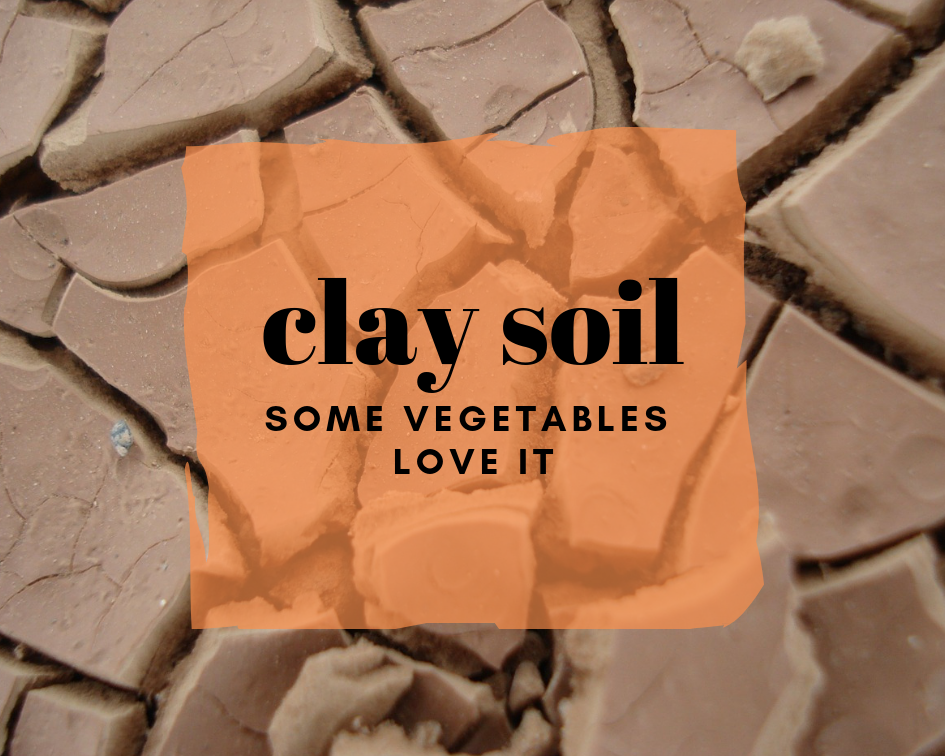This post may contain affiliate links. As an Amazon Associate we earn from qualifying purchases.
How to grow garlic: Here’s your complete guide!
How can something that stinks up our breath so badly be so tasty? Not to mention that it comes in handy when vampires attack and it has health benefits. Also, garlic is easy and fun to grow in the home garden.
Garlic (Allium sativum) has been around for a very long time. In fact, “… Hippocrates (circa. 460-370 BC) … prescribed garlic for a wide range of conditions and illnesses,” according to Peter Morales-Brown at MedicalNewsToday.com, citing a piece written by Richard S. Rivlin in the Journal of Nutrition.
Some of the prescriptions Hippocrates handed out were to treat “… respiratory problems, parasites, poor digestion, and fatigue,” Morales-Brown concludes.
A relative of the scallion, chive, leek, and shallot, garlic reigns supreme when it comes to cooking a tasty meal.
Ok, let’s get to learning how to grow garlic in our own garden.
Choosing the Right Garlic
When it comes time to grow garlic, it’s essential to choose the right type of garlic. There are two primary types: hardneck and softneck.
Hardneck varieties typically have larger cloves, and they produce a central flowering stem called a scape. The flavor is “… closer to wild garlic, with complex flavors,” according to the experts at GrowOrganic.com.
They also love the cold, so if you live in a chilly climate, this may be the garlic for you.
Softneck garlic is the one we most commonly find in grocery stores. The cloves are smaller than those of its hardneck cousin and because their necks are soft, they’re pliable enough to braid.
See the section on popular varieties toward the end of this post to learn more.
Timing is Everything When You Grow Garlic
Like most things in life, timing is everything and it’s no different with gardening. The best time to plant garlic is in the fall. Wait too late in the fall, however, and if you live in an area where winter hits hard and early, you might as well just wait until the following year.
Why? Garlic seeds need a bit of time to produce roots before winter and dormancy sets in.
When is too late? It depends on where you live. Gardeners in Massachusetts, for instance, can safely plant garlic between October 1 and November 15, according to the experts at the University of Massachusetts Extension.
California gardeners, on the other hand, should plant in January or February and in Minnesota, the extension folks say to plant within one to two weeks after the first killing frost.
Check the website of your state’s cooperative extension office or give them a call (you’ll find a list of all 50 states’ and Puerto Rico’s extensions, here). There are also alternative ways of figuring out when to plant garlic:
- Plant garlic immediately after the first frost (you should be ok planting it up to two weeks after as well).
- Or, use a soil thermometer to determine the soil’s temperature. Take the reading in the morning, at about 9 a.m. when it’s had a chance to warm a bit. Insert the thermometer to a depth of 4 inches. If the temperature registers 50 degrees Fahrenheit, you’re good to go: it’s time to grow garlic!.
Choose and Prepare the Right Place to Plant and Grow Garlic
Take a look at your garden at various times throughout the day, watching the sun’s pattern as it crosses against the sky. Choose a planting site that gets at least six hours of full sun (8 is even better).
Garlic requires fertile soil and requires a lot of nitrogen, Compost is the ideal substance to use but you can also use soybean meal or well-rotted manure when planting. It’s also important to supply garlic with phosphorus and potassium if a soil test find it lacking.
A wise move is to test your soil’s nutrient content before planting. Then, follow the phosphorus and potassium recommendations of the soil test. Mix the fertilizers into the soil before planting. Shop for a soil testing kit here.
- When amending, mix 2 to 4 inches of compost (or whatever you’ve chosen) into the top 6 inches of soil. Remove any rocks that turn up to avoid impeding the garlic’s growth.
- Level the bed with a rake to ensure there aren’t any divots that will hold water.
- Finally, test the soil’s pH. It should be between 6 and 7. Check out this pH meter at Amazon.com.
Yay! It’s Time to Plant Garlic
Grab that head of garlic and separate all the cloves. There’s no need to remove the papery stuff surrounding them. Plant each one with the pointed end facing up, 2 to 4 inches deep. We like to plant the small cloves at the 2-inch depth and the large ones a bit deeper.
Space each clove 6 inches apart and, if you’ll be planting lots of garlic, space your rows 12 inches apart.
“A bulb planter used for tulips and daffodils is an excellent tool to get a number of cloves planted quickly,” according to the agriculture experts at UMassExtension.
Water well after planting and then spread a layer of organic mulch, such as dried leaves or straw, on the soil around the garlic plants. Mulch is the workhorse of the garden, insulating the soil, retaining moisture and suppressing weeds.
 Caring for Your Growing Garlic
Caring for Your Growing Garlic
Watering Garlic Plants
I remember the first time I grew garlic. Perusing my gardening books I was surprised to learn that garlic needs consistent moisture. When purchased at the grocery store, garlic has that same papery covering as onions. They just look like something that would like dry-ish soil.
What I learned is that most of the water we provide garlic will be given during its early growth. That makes sense, right? The crop needs those green garlic scapes (yummy to eat too, by the way) to feed the growing bulb.
Now, that doesn’t mean it can thrive in soggy soil. Just ensure that the baby garlic doesn’t sit in dry soil for too long.
Watch the foliage. If it turns yellow, cut back on how often you water. Overall, with the exception of garlic grown in sandy soil, you’ll want to provide about an inch of water a week (if it doesn’t rain) in autumn.
Stop watering the garlic when the leaves at the bottom of the plant turn brown while the tops remain green. This should occur a few weeks before harvest, so keep an eye on your plants.
Fertilizing Garlic
Post-planting fertilizer needs vary a bit. Garlic loves lots of nutrients in the soil and many growers recommend a balanced, 19-19-19 fertilizer. Garlic also needs a bit of extra potassium, so grab a bag of 0-0-50 as well (see the Resources section at the end of this blog post).
Wait until the plants have at least two sets of leaves to fertilize. This will typically occur in spring.
If you’ve never side-dressed your crops, you’ll learn something new today.
- Dig a 2 to 3-inch trench, 6 inches to the side of the garlic plants’ stems.
- Sprinkle the fertilizer into the trench, all the way down the row. The recommended rate is 0.9 pounds of 19-19-19 per 1,000 square feet of garlic bed. Feel free to round that up to an even pound.
- Next, do the same with a handful or two of the potassium. Not too much, just sprinkle it lightly over the fertilizer. Combine both amendments into the soil.
- Cover the trench and water well.
When and How to Harvest Garlic
Keep an eye on the garlic plants’ foliage. When the leaves toward the bottom dry out, it is ready for harvest. This typically occurs between 6 and 8 months after planting.
Use caution when harvesting, as injury to the garlic can cause problems after harvest. Use a hand fork (see the Resources section, below) to gently lift the bulbs from the soil. If aren’t comfortable using a tool, use your gloved hands.
It’s important to be gentle with the bulbs when harvesting. “do not bang the soil off the roots, but give the bulb a quick hand rub or a shake to get the soil off, leaving an uninjured bulb and one to two inches of roots, ” cautions Richard M. Hannan and Eric J. Sorenson with the Washington State University Extension. By the way, if you need more information on growing garlic, the WSU Extension article is a must-read.
Place the bulbs in a shady, dry area that receives a bit of ventilation and remains warm. Give them three weeks in this spot and then cut the roots to 1/2 inch and the the stem to one inch.
Common Garlic Plant Pests and Diseases
Garlic Pests

Perp: Nematodes (several types)
Gardeners have a love/hate relationship with nematodes. Most aren’t harmful, while others can cause illness in humans, pets, livestock and plants. Nematodes are parasitic, “… translucent, unsegmented worms that measure about 1/50 inch long,” (editors, GoodHousekeeping.com). So no, we can’t dig in the soil and pick them out to destroy them .
Symptoms: Nematodes love to munch on garlic’s roots which leads to stunted growth and yellow leaves. The worst offender of all of them, however, is the bloat nematode (Ditylenchus dipsaci). These pests leave behind yellow skin on the garlic, “… roughened cracked and/or swollen tissue,” (Cornell University) and no, or very few, roots.
Treatment: The best treatment is prevention.
Prevention: This includes crop rotation (don’t plant garlic, onions, etc. again in the bed for three years) and beneficial nematodes. Purchase Steinernema carpocapsae (see the Resources section, below, for where to buy).
“Add to your soil in the fall just before planting your garden and then again work them around your garlic in the early to mid-spring,” recommends Larry Stebbins, author of “The Backyard Vegetable Gardening Guide” and “No Strain Gardening.”

Perp: Onion Thrips (Thrips tabaci)
Very small insects that munch on the garlic plants’ stalks.
Symptoms: “… whitish blotches that may appear as silvery streaking on leaves,” according to David Lowenstein and Russell Groves at the University of Wisconsin, Madison. See the above photo.
Control: Lacewings and ladybugs (both predatory insects).
Prevention: Introduce predatory insects like ladybugs or lacewings to prevent and control thrips populations. These are available at some nurseries and online. Visit the Resources section, below this post to order yours.
Perp: Onion Root Maggot (Delia antiqua)
The larvae of small gray flies (Delia spp.). “The first generation of onion maggots primarily feeds on seedlings, however the second and third generations of onion maggots will feed on the expanding bulb of the maturing plant,” according to Sue Kitteck at The Morning Call.
Symptoms: Young plants wilt. Pull one up to inspect the roots for small, white maggots.
Control: Apply Steinernema feltiae (beneficial nematodes) to the soil per instructions on the package.
Prevention: Use row covers during early growth to discourage the flies. No flies, no maggots.
Garlic Diseases
White Rot
A post-harvest fungal disease caused by Sclerotium cepivorum, white rot can devastate not only the crop, but the bed as well. “… white rot can render a field unusable for garlic or other Allium species for as long as 40 years, even without an Allium host,” according to Steven B. Johnson, Extension Crops Specialist, at the University of Maine.
Suspect white rot if the lower, older leaves start to decay, turning yellow. They will eventually wilt and fall over.
“Roots rot and the top of the plant can be pulled out of the ground easily,” according to experts at the United States Department of Agriculture. Inspect the bulbs and the roots and if they’re covered in a white fluffy substance,” (USDA) suspect white rot.
Management includes proper sanitation of gardening equipment and the destruction of bed litter. Extension specialists also suggest a careful selection of seed garlic.
Fusarium basal rot
If the garlic plant’s foliage turns yellow and the leaves begin to turn brown at the tips, suspect Fusarium basal rot, a fungal disease.
Pull up one of the plants and inspect the roots. If they’ve turned dark pink or brown, the plant is most likely infected with this disease.
For more on this disease, visit perennia.com.
Popular Garlic Varieties
Softneck Garlic
California Late White: “California Late is more on the hot side with a classic garlic flavor,” according to the pros at Urban Farmer Seeds. It is the most commonly grown garlic in the U.S. Grow this if you live in some of the warmer parts of the U.S. Hardy to USDA Hardiness Zones 3-9. Shop here for California Late White garlic seed.
California Early: This one was developed for the California garlic industry, according to the experts at Burpee Seeds. It’s mild and quite adaptable to various climates. Some say it has a too-long growing period but admit that it was worth the wait. Grow this one in USDA Zones 7-10. Shop here for California Early White garlic seed.
Italian Late A mild flavor with medium heat makes Italian light popular with home gardeners. Oh, and the fact that it stores for up to 8 months doesn’t hurt its popularity. This one is hardy to USDA Zones 3-9. Shop here for Italian Late garlic seeds.
Hardneck Garlic
Music: Offers the complex flavors we expect from hardneck garlic, and then some. This is probably the most popular variety on the list and, YAY! It’s a good one for the beginning garlic grower and thrives in cold weather. Music is hardy to USDA Zones 2 to 8a. Shop here for organic ‘Music’ seed.
Spanish Roja: Also known as Greek garlic (don’t ask me why) this one has a flavor that knocks you upside the head. Chefs love it for it blast of garlic flavor and home growers sing its praises because it stores quite well. This is an early-season garlic. Shop here for organic ‘Spanish Roja’ garlic seeds.
Killarney Red: A variety of Rocambole (Allium sativum var. ophioscorodon) this is one of the most flavorful garlic varieties. It is quite popular with chefs for its intense flavor. It is also super easy to grow, as this particular variety of Rocambole doesn’t mind having wet feet. Shelf-life is short, however, lasting only 2-3 months. If it rains a bit in your area, you may want to choose another variety. This garlic is hardy to USDA Zones 5-9. Shop here for Killarney Red garlic seed.
Elephant garlic: Not a true garlic, but a type of wild leek, Elephant Garlic is milder than typical garlic but can be used in many of the same recipes that call for garlic. Elephant garlic requires “… a long, cool growing season,” according to the experts at Burpee Seeds. Shop here for Elephant Garlic seeds.
Bonus! How to make garlic powder (go to 1:19)
Resources
Soil Thermometer
Fishnure Compost
Soybean Meal
19-19-19 Fertilizer
Sulfate of Potash 0-0-50 Fertilizer
Steinernema carpocapsae beneficial nematodes
Pest Barrier Row Cover
Hand Fork
“The Backyard Vegetable Gardening Guide”
Live Lady Bugs
Steinernema feltiae (Beneficial Nematodes)







